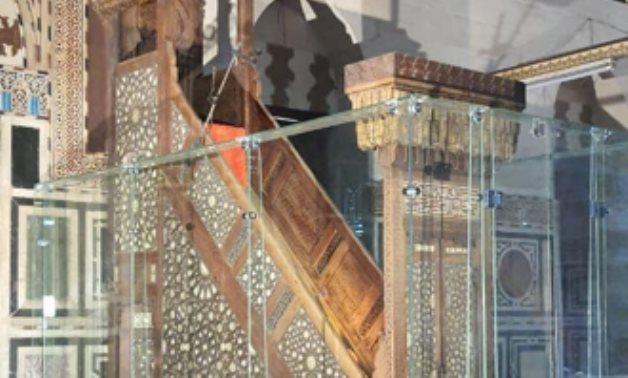
The protection screen was placed around the pulpit of the ancient Abu al-'Ila Mosque - Photo via Egypt's Min. of Tourism & Antiquities
CAIRO – 26 July 2020: The Ministry of Tourism and Antiquities, represented by the Supreme Council of Antiquities, has completed the installation of the first transparent protection screen around the pulpit of the Sultan Abu al-'Ila Archaeological Mosque.
This comes within the framework of the Mamluk archaeological pulpits project.
Mostafa Waziri, secretary general of the Supreme Council of Antiquities, said that this project was implemented as per the decision taken by the Permanent Committee of Islamic and Coptic Antiquities in the last few months to protect these platforms after many of them were stolen over the past years.
Waziri stressed that these barriers would reduce the risk of theft by up to 85 percent, according to the study of assessing and warding off risks at Mamluk platforms. It is also considered one of the strategies that protect the pulpit from the risk of scratches and loss of fillings resulting from pressure and friction.
Assistant Minister for Engineering Affairs Hisham Samir explained that this barrier is made of triplex glass with a thickness of 10 millimeters to provide the pulpit with the greatest degree of protection, as it can withstand attempts of breaking in for as long as possible, which prevents the thief from reaching the fillings that decorate the pulpit. Samir stressed that it is also protected by an inner layer that combats shocks, so that if glass cracks, it won't fall on the ground.
Furthermore, the barrier was provided with a door opposite the door of the pulpit, to be used by the Khatib or preacher. It has two terraces and a Patch Fitting Lock with a computer key.
The archaeological value of the mosque and the pulpit was taken into account during the installation. A good vision of the pulpit's details and fillings was ensured by using the best available type of glass, as well as adopting a design with the largest possible area for the glass panels so that the vision is not interrupted by many barriers.
Comments
Leave a Comment